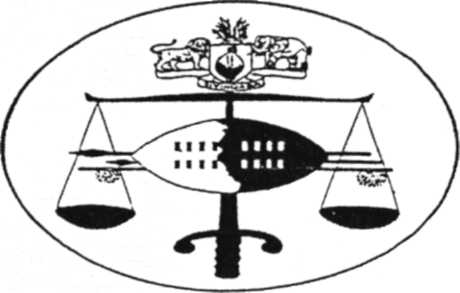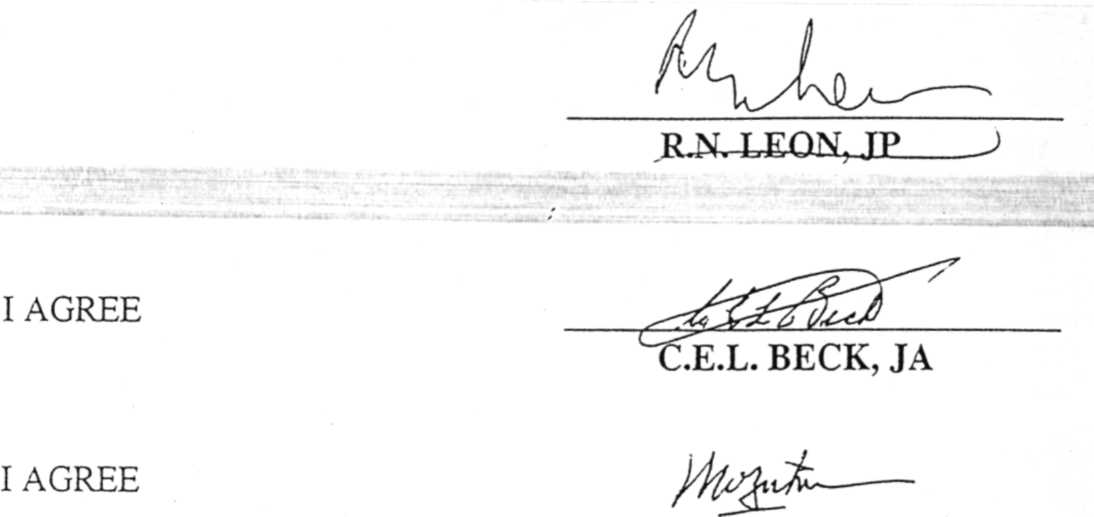

1
IN THE COURT OF APPEAL OF SWAZILAND
HELD AT MBABANE In the matter between MUZISHABALALA AND ANOTHER and THE KING Coram Criminal Case No.32/2002 Appellant Respondent LEON, JP BECK, J A ZIETSMAN, JA
JUDGMENT LEON, JP The two appellants, despite their pleas of not guilty, were found guilty of murder with extenuating circumstances. The first appellant (Muzi) was sentenced to seven years' imprisonment and the second appellant was sentenced to five years' imprisonment. Both sentences were backdated to 15 October 2000. Indeed we were
informed by Mr. Mamba, for the appellants, that the second appellant has served his sentence. The matter came before the Court in November 2002. At the time the judgment of the Court a quo was not available and the Court ordered that all attempts must be made to see whether Mr. Justice Matsebula (the trial judge) could make his judgment available before the end of that session. That did not occur. On 4 October 2004 the trial Judge sent a note to the Registrar of this Court. He stated that after diligent search from Judges' notebooks dating as far back as 11 December 2001 he had been unable to trace his judgment. He has also been informed by his secretary that tapes which were brought to her for transcription were missing. It is also to be noted that at page 99 of the record, which was during the address by counsel for the Crown, it is stated that the record is inaudible. Whether that would refer to any judgment handed down is not clear. However, what is clear is that there is no judgment and that no judgment can be produced.
We decided to hear the appeal despite the fact that there we were not in possession of the judgment and Mr. Mamba agreed to this. With regard to the notice of appeal the first ground is that the trial was a nullity as the case was brought in the name of the King instead of the Director of Public Prosecutions. We were informed by Mr. Mamba that this point had been abandoned at the last sitting of this court in November 2002 in view of a judgment of mine in another case in which this point was dismissed. The background to this case is that the first appellant is the father of the second appellant. The first appellant had a daughter aged about 13 who became ill. That daughter was, of course, the sister of the second appellant. It is not in dispute that both appellants believed that the deceased was responsible, through witchcraft, for causing the child to become ill. It is also common cause that, on the day mentioned in the indictment, the second appellant assaulted the deceased with a knobstick and the first appellant assaulted her with a stick.
The question which the trial court had to decide was whether the appellants were guilty of murder. In this regard both appellants pleaded guilty to assault with intent to do grievous bodily harm and it was Mr. Mamba's contention that they should have been convicted of no more than that. It appears from the record that the post mortem report was handed in by consent as exhibit "A", that report is not before us but according to what was stated by the trial Judge during the trial, the deceased had died from haemorrhage caused by multiple injuries. Reading from that report the learned Judge a quo noted that the doctor had listed six items and that under each item were a large number of injuries. This suggests a ferocious and sustained attack upon the deceased. Mr. Mamba did not challenge what the learned Judge said of the post mortem report. I turn now to refer to the evidence relating to the death of the deceased. The husband of the deceased Phineas Sibandze testified as PW1. On the 14th October 2000 the two appellants arrived in the middle of the night looking for the deceased. They went with the deceased to the Shabalala household where the sick child was. He heard the sick child mention the name of the deceased. At that stage the second appellant hit the deceased
over the head with the knob part of the knobstick. The first appellant joined in by assaulting the deceased with a stick. PW1 then asked the appellants whether they had called the deceased in order to kill her whereupon they responded that the deceased was causing them misery because she was the one who had bewitched the sick child. He asked them what evidence they had that it was the deceased who was bewitching the child. They said 'that they had such evidence and continued hitting the deceased. He then asked them if they were aware of what they were doing and that the deceased was dying. They replied that indeed they were killing her. The first appellant then seized a spear but did not use it. He asked them again why they were killing the deceased and they said that they could not stay with a witch. They would kill her and PW1 would have to bury her. This evidence is of great importance as it shows an actual intention to kill by both the appellants who were acting in concert. Prior to the fateful day PW1 said that he enjoyed a good relationship with the appellants who were his neighbours and that he was amazed that this incident had occurred but that, having done what they had done to his wife, he no longer regarded them as good neighbours.
He added that both the appellants were in a fighting mood and that when they fust arrived at his house they were carrying the sticks with which they had killed the deceased. Before the assault PW1 knew nothing about the sickness of the child being allegedly caused by the actions of the deceased. In describing the details of the assault he described how the second appellant had held the knobstick with both hands hitting the deceased with the knob part of the stick until she lost strength and fell down. He denied the defence suggestion that the first appellant had merely grabbed a piece of firewood with which he had hit the deceased twice. He insisted that he had hit the deceased several times with the very stick which he was carrying when he first arrived. Realising that the deceased was dying PW1 went off to seek help. PW1 was a good witness who was not discredited in cross-examination. Moreover his evidence is entirely consistent with the medical evidence. Constable Absalom Dlamini was PW2. In consequence of a report he went to the scene of the crime. He found the first appellant sitting on a chair. He asked him what had happened but he received no reply. He
then observed that the deceased was naked and bleeding profusely from wounds on her head. He took her to hospital but she died there shortly after they had arrived. He noticed that the first appellant was very angry. He did not encounter the second appellant at the scene. PW3 was Detective Sergeant Joseph Msibi. He arrested the appellants who voluntarily handed over the knobstick and the stick in question. Mbhekeni Shabalala was the brother of the deceased. He was PW4. He was awakened late at night on the day in question and repaired to the scene of the crime. He found both the appellants beating his sister. When he asked them why they were doing that they replied that she was bewitching the child. The first appellant told him to go and look at the child who was a dead body in the house. He found the child leaning against the bed. The deceased then called out to him. He saw the first appellant step on the deceased with his boot saying that she was not dying but faking death. In the light of the evidence of the appellants that they did indeed assault the deceased counsel for the defence remarkably put to this witness that neither of the appellants had ever assaulted the deceased. That was denied.
Both appellants gave evidence under oath. The first appellant testified that at about 9 p.m. on the day in question his child was sick crying out the name of the deceased. He observed that the child was scratching herself, biting herself and was full of blood. He went to the household where the deceased was accompanied by his son, the second appellant. They told the deceased that they wanted her as a neighbour to see what could be done for the sick child. The deceased and her husband agreed to see the sick child. When they went to the sick child the first appellant asked the deceased whether she was responsible for the child's sickness. The deceased admitted that she was because she was "fixing up my wife who was cheeky." The deceased added that she could not reverse the sickness for the child would ultimately die. It was then that the second appellant beat the deceased with a knobstick by holding the knob and hitting the deceased with the stick. The first appellant then asked the deceased for the muti which she said she had hidden in the barn whereupon the first appellant hit the deceased with a stick causing her to fall down. She was bleeding profusely. He said that he had hit the deceased three times. He denied that they had arrived at PWl's house carrying sticks and denied further that he had stated while beating the deceased, that he intended to kill her. But he admitted being angry and
shocked when told that the deceased was responsible for the illness of his : child. When invited to explain the medical evidence that scores of injuries had been found on the deceased, the first appellant then stated for the first time that, when the deceased fell down she fell on rocks and sustained further injuries. This, he said, explained his evidence that he had assaulted the deceased thrice and that his son had assaulted the deceased thrice. Such a suggestion was never put to any of the Crown witnesses nor were they asked about the presence of rocks. The second appellant gave similar evidence. He claimed to have assaulted the deceased twice on the head with the stick part of the knobstick and once on the hand. He admitted using much force. With regard to the alleged presence of rocks his evidence refers to gravel and some stones. I have no doubt that the suggestion of the deceased hitting her head on rocks and/or stones and/or gravel was an afterthought.
Mr. Mamba contended that these appellants were acting independently and that no common purpose was proved. Such an argument is without substance. The credible evidence of PW1 shows clearly that the appellants were acting in concert and that they had an actual intention to kill the deceased. The medical evidence supports such 'an intention given the large number of injuries sustained by the deceased and Mr. Mamba frankly and correctly conceded that there is no possibility of some third person being involved in the killing of the deceased. Added to all this is the anger of the appellants arriving late at night armed with weapons believing that the deceased was a witch. Finally the evidence of the appellants is completely at odds with the medical evidence and their suggestion of rocks or stones is a preposterous afterthought. There is no merit in the appeal against the convictions and there is no appeal against the sentences. The appeal is dismissed and the convictions and sentences are confirmed.
DELIVERED IN OPEN COURT THIS...DAY OF NOVEMBER 2004 N.W. ZIETSMAN, JA
